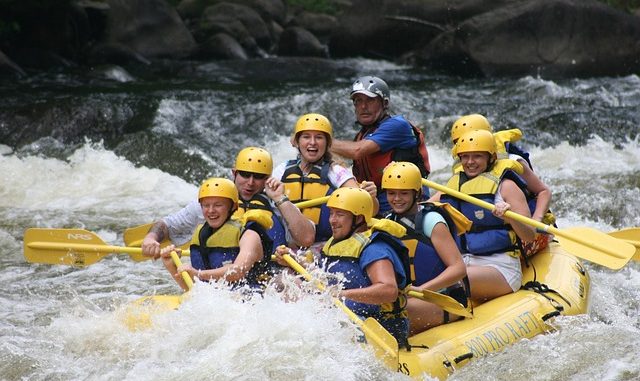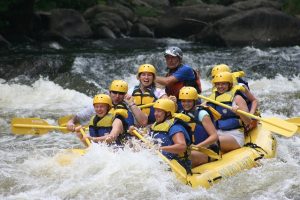
Whitewater rafting uses an inflatable raft to navigate a natural or manmade river. For wave after wave of thrills and excitement, whitewater rafting is ideal for a group of your friends or for stag or hen weekends.
Skills – Strength: 4, Balance: 5, Flexibility: 3, Agility: 1, Coordination: 5
Time needed: 2 hours, Cost to try: £50.
Whitewater rafting is a very thrilling way to go down a river. There are three types of river that you can go rafting on. These are:
- a man-made whitewater river, like the London 2012 Olympic whitewater river at Lee Valley. This river is controlled and is used for canoeing competitions. A man-made river is ideal for spectators to see the entire stretch of water.
- Dam release rivers such as Canolfan Tryweryn – The National Whitewater Centre in Bala, Wales. Dam release rivers use the periodical release from dams to create the whitewater. The advantage of this type of river is that you can use it for whitewater rafting when other rivers have dried up during hot weather.
- A natural river such as the River Dee or Colorado. This whitewater river is not dependant on Dam releases as other Welsh venues are, which makes us truly the only year round White Water Rafting in Wales.
 The rafts used are not the old fashioned set of logs tied together as made when you are in Scouts. They are inflatable boats that are resistant to the buffeting that is experienced when whitewater rafting down a wild river. Whitewater rafting can be a dangerous sport, so there are various safety precautions that must be taken. Depending on the area
The rafts used are not the old fashioned set of logs tied together as made when you are in Scouts. They are inflatable boats that are resistant to the buffeting that is experienced when whitewater rafting down a wild river. Whitewater rafting can be a dangerous sport, so there are various safety precautions that must be taken. Depending on the area
, legislated safety measures now exist for rafting operators. These range from certification of outfitters, rafts, and raft leaders, to more stringent regulations about equipment and procedures. It is generally advisable to discuss safety measures with a rafting operator before signing on for a trip. The equipment used and the qualifications of the company and raft guides are essential information to be considered.
Video of whitewater rafting in New Zealand
With paddle in one hand and helping to carry the raft in the other hand, you set off onto a calm piece of water at the head of the river. Then you all head off over the first weir. The advantage of the manmade river is that the instructor will guide the team in the raft to the calm eddies at the side of each weir to brief them on how to tackle the next weir. The instructor explains what to do and then you experience how the raft behaves as you cross from one side of the water to the other. If you should happen to fall out, all you do is just lay back and float. The remainder of your team in the raft have to paddle to reach you and then pull you into the raft. The downside of the manmade river is that it is shoprt compared with a natural river, and when you reach the bottom you all have to get out and carry the raft back to the head of the river for another whitewater run. If you are on a natural river, you just go down once, but the distance is much further.
Find Out More About Whitewater Rafting
There are several great places to go whitewater rafting in the UK.
- Holme Pierrepoint at the National Watersports Centre in Nottingham
- Canolfan Tryweryn, the National Whitewater based near Bala, North Wales
- Whitewater Active. JJ Canoeing and Rafting is one of the Uk’s leading White Water Rafting and Canoeing Centre based in Llangollen, in North Wales.
- Lee Valley, near London. This is the London 2012 Olympic whitewater rafting venue. One of the cool things about this venue is that it has a lift to take your raft back up to the top. No carrying it all the way back up the river!
Some of the best places to go white water rafting are all in the Americas. Canada, Idaho and Ecuador feature, with other locations including Australia, Italy, Nepal and the Zambezi. I want to try whitewater rafting on the wild waters of the Noce River in Italy. The Noce flows through the Val di Sole in the Dolomites of northern Italy. It has some of the most exciting whitewater rafting in Europe, with an amazing set of Class V rapids as it roars through the gorges of Mostizzolo. You have got to try whitewater rafting in the Dolomites.
If you prefer something a bit more sedate, you could always try raft building.
